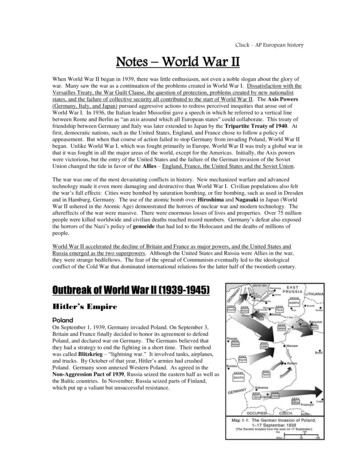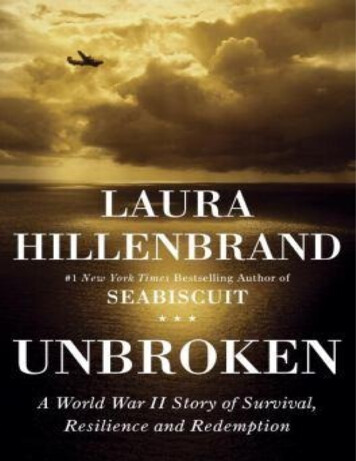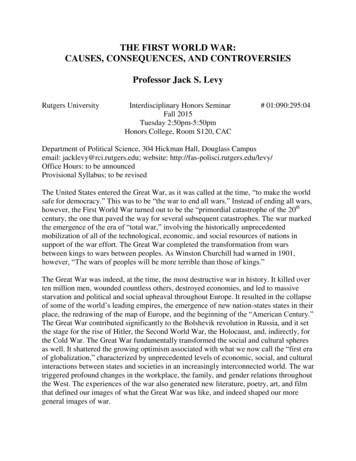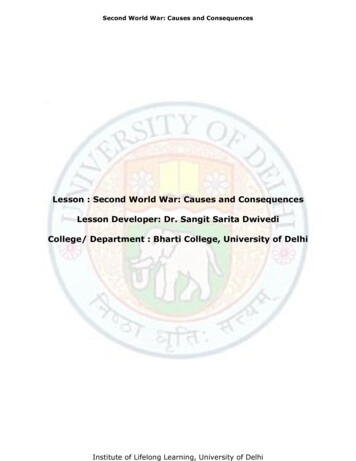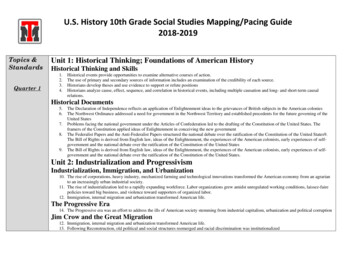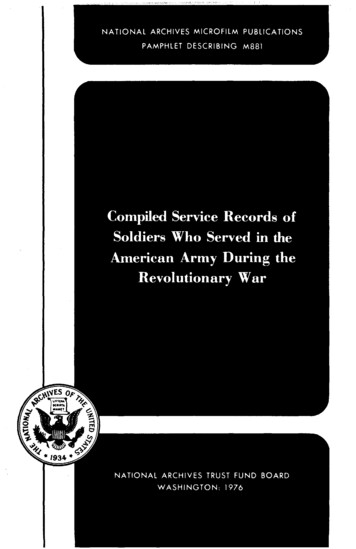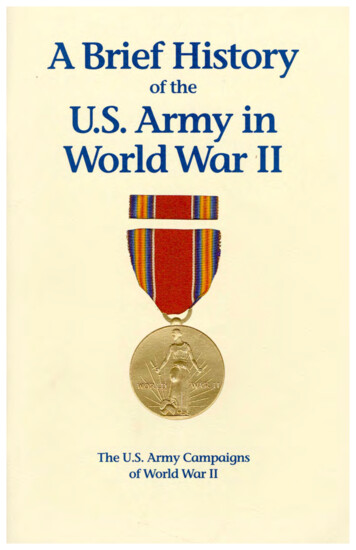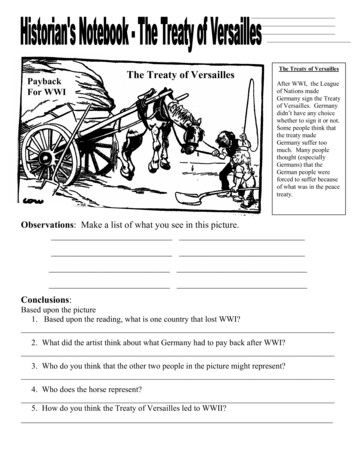
Transcription
PaybackFor WWIThe Treaty of VersaillesThe Treaty of VersaillesAfter WWI, the Leagueof Nations madeGermany sign the Treatyof Versailles. Germanydidn’t have any choicewhether to sign it or not.Some people think thatthe treaty madeGermany suffer toomuch. Many peoplethought (especiallyGermans) that theGerman people wereforced to suffer becauseof what was in the peacetreaty.Observations: Make a list of what you see in this picture.Conclusions:Based upon the picture1. Based upon the reading, what is one country that lost WWI?2. What did the artist think about what Germany had to pay back after WWI?3. Who do you think that the other two people in the picture might represent?4. Who does the horse represent?5. How do you think the Treaty of Versailles led to WWII?
U.S. Involvement in WWIIAfter WWI, many people in the United Stateswere isolationists. This meant that they didn’twant to become involved in the problems ofthe world. When Nazi Germany invaded thecountry of Poland in 1939, Great Britain andFrance declared War on Germany because ofwhat they did. The United States didn’t doenter the war against Germany. Many people,especially those in Great Britain became angryat the United States. When Germany startedopenly attacking Great Britain and France,both of those countries turned to the UnitedStates for help. The United States gave themmoney and weapons but wouldn’t commit anytroops. This cartoon was made in the 1940s byDr. Seuss, before he was an author ofChildren’s books. He was from England andwas criticizing the United States for notcoming to the aide of its allies. It was onlymuch later after the war that Dr. Seuss becamemore famous for his children’s books, than hispolitical cartoons that he drew during WorldWar II.Observations: Make a list of what you see in this picture.Conclusions: Based upon the picture or the reading, answer the following questions:1. Based upon the reading, how did the United States first act during WWII?2. What do you think Dr. Seuss felt about the United States?3. Who does the bird represent in this picture?4. What is the United States “doing” in this picture?5. Which two countries came to the immediate aide of Poland?
Women at WarWhile women were not allowed to fight in battle as soldiers, there weremany things they could do to help the war effort. The first thing theycould do was to help conserve precious resources by not overspendingand by saving what they could. The graphic on the left is a realpropaganda poster that tried to convince women not to overspend whenthey went shopping. Many women didn’t simply just save money bybeing thrifty, some also entered the workforce so that their husbandscould enter the marines.War work was dirty work; You needed to work fast, accurately andpossibly beat previous records. So the intrusion of women into heavyindustrial work was a culture shock for their male colleagues. Somereacted resentfully, but most accepted working women. In the end,women performed far better than expected and were a good addition tothe work force.Women had a hard time adapting to the work schedule. They needed tochange their dress habits and had to limit their time to do other thingslike shopping, housekeeping and supervising children. Luckily their washelp for them; Some companies ordered special work clothes for womenthat were fashionable, yet practical. Also grocery stores and departmentstores stayed open later so that they could meet the working women’sneeds. Lastly, the federal government, helped build and operate some,2,800 childcare centers to help working women.Observations: Make a list of what you see in this picture.Conclusions:Based upon the picture1. Based upon the graphic, who does the bug represent?2. What are two different ways that women could support the war effort?3. How did conserving food and money actually help the war effort?4. What were some challenges that women faced when entering the workplace?5. How many child care centers opened across America during WWII?
During the 50th anniversary of WorldWar II, as we honor those Americanswho undauntedly and courageouslycontributed to the defense of ournation, often overlooked in ourremembrances are the valiant effortsof African Americans. Throughoutthe war years they repeatedly had tobattle adversaries on two fronts: theenemy overseas and racism at home.Black Americans recognized theparadox of fighting a world war forthe "four freedoms" while beingsubjected to prejudicial practices inthe United States. Thus, as the warunfolded, they vehemently insisted onthe privileges of full citizenship.African Americans were ready towork and fight for their country, butat the same time they demanded anend to the discrimination againstthem.To that end, over 2.5 million AfricanAmerican men registered for the draft,and black women volunteeredin large numbers. While serving in the Army, Army Air Forces, Navy, Marine Corps, and Coast Guard, they experienced continuing discrimination andsegregation. Despite these impediments, many African-American men and women met the challenge and persevered. They served with distinction, madevaluable contributions to the war effort, and earned well-deserved praise and commendations for their struggles and sacrifices.On the homefront, black Americans also did their part to support the war. They worked in war industries and in government wartime agencies, sold warbonds, voluntarily conserved goods needed for the war, performed civil defense duties, encouraged troops by touring camps as entertainers, risked their liveson the front lines to report the war, and performed many other vital services.Observations: Make a list of what you see in this picture.Conclusions: Based upon the picture or the reading, answer the following questions:1. What were two things that African Americans did to help the war effort?2. What were some things that African Americans “demanded” as the war unfolded?3. How do you think it was different for black soldiers compared to white soldiers?4. How many African Americans fought in the war in some capacity?5. Name two causes of WWII.
VE Day finally arrived on May 8, 1945 after fierce efforts by the allied forces. The previous year British, Canadian, and U.S. ftroops invaded Normandy, andbegan to drive the Nazis out of France. At the same time, the Soviets were launching their own counter-offensive. They pushed the German army completelyout of Europe. Seizing their advantage, the Soviets advanced into Poland, Czechoslovakia, Hungary and Romania.By 1945, the German defenses had begun to collapse. The Soviet army occupied the eastern one-third of Germany. Eventually, the allies surounded Berlin.On April 30, Adolf Hitler commited suicide. Germany surrendered soon after.Observations: Make a list of what you see in this picture.Conclusions: Based upon the picture or the reading, answer the following questions:1. What do you think V-E stands for?2. How were the allies eventually able to defeat the Nazis?3. Why are these people celebrating in the picture?4. When did Hitler kill himself?5. Why do you think Hitler committed suicide?
The “Final Solution” was the plan that the Nazis had to kill all of the Jews in Europe. Under this plan, they were able to kill nearly 6million jews. They did this either in mass slaughter sites in towns or by forcing Jews to relocate to one of the 8 extermination camps.An SS has the woman (whose hair is covered in the tradition of an Orthodox Jewish wife) with her infant child to join those beingsent to the crematoria (picture below). We also can see a man that is standing between the columns missing his pants and one shoe.This was a common occurrence in the overcrowded boxcars. On the left stand inmates in striped camp clothing. The main gate to thedeath Camp under which the train pass is at the rear left of this historic photograph.Observations: Make a list of what you see in this picture.Conclusions: Based upon the picture or the reading, answer the following questions:1. What was the Holocaust?2. Why do you think the Nazis wanted to kill all the Jews in Europe?3. What were two of the ways that Nazis would kill large numbers of Jews?4. Based upon the evidence, what do you think the smoke could be from?5. What is a similar situation that is happening right now in the world?
D-DayD-Day is a military term that refers to the basicdate and time from which an important event,usually an attack, could be scheduled. In otherwords, the “D” in D-Day merely stands forDay. For military planners, the days before andafter a D-Day were indicated using plus andminus signs: D - 4 meant four days before a DDay, while D 7 meant seven days after a DDay. The best known D-Day was June 6, 1944,during World War II, when Allied forceslanded in Normandy, France.In the early morning of June 6, thousands ofAllied paratroopers landed behind enemy lines,securing key roads and bridges on the flanks ofthe invasion area. As the sun rose on theNormandy coastline, the Allies began theiramphibious landings, traveling to the beaches insmall landing craft lowered from the decks oflarger ships anchored in the Channel. Theattack on four of the beaches went according toplan. But at Omaha Beach between Utah andGold, the bravery and determination of the U.S.1st Infantry Division was tested in one of thefiercest battles of the war.Observations: Make a list of what you see in this picture.Conclusions:Based upon the picture1. What was D-Day?2. When did D-Day occur?3. What do you think the men in this picture are doing?4. What were the paratroopers trying to do?5. Name one cause of WWII?
The HolocaustThe Holocaust was the mass murder of six million Jewsand millions of other people leading up to and during theSecond World War.The killings took place in Europe between 1933 and1945. They were organized by the German Nazi partywhich was led by Adolf Hitler.The largest group of victims were Jewish people. Nearly7 out of every 10 Jews living in Europe were murdered.Most of the victims were killed because they belongedto certain racial or religious groups which the Naziswanted to wipe out. This kind of killing is calledgenocide.The Nazis also killed large groups of people who theythought were inferior. We will never know exactly howmany died but there were many millions of non-Jewishvictims, including: Civilians and soldiers from the Soviet UnionCatholics from PolandSerbiansRomany GypsiesDisabled peopleHomosexualsJehovah's WitnessesObservations: Make a list of what you see in this picture.Conclusions: Based upon the picture or the reading, answer the following questions:1. Based upon the reading, what do you think this is a picture of?2. Why do you think these men look like this?3. Why do you think people allowed such a horrible thing as the holocaust to happen?4. What is a situation that is happening in the world that is similar to the Holocaust?5. What percentage of Jews in Europe were killed?
Children’s books. He was from England and was criticizing the United States for not coming to the aide of its allies. It was only much later after the war that Dr. Seuss became more famous for his children’s books, than his political cartoons that

